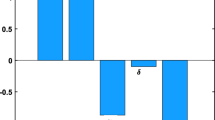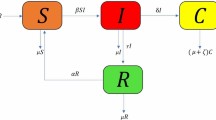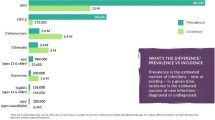Abstract
Cervical cancer is one of the most common cancers among women globally, with more than three quarters of its global burden occurring in developing countries and one of the most common cancer among Indian women. Cervical cancer cases (more than 95%) are linked to infection with high-risk human papillomaviruses (HPV). HPV is mostly transmitted through sexual contact, and majority become infected with HPV shortly after sexual activity begins. This paper develops a mathematical model for HPV transmission and its impact on cervical cancer. The basic properties of the system are discussed in detail. Using the next-generation matrix method, we obtain the basic reproduction number and prove that the disease-free and endemic equilibrium are globally asymptotically stable under certain conditions. Numerical solutions of the proposed model are carried out using the fourth-order Runge–Kutta method to demonstrate our theoretical results.The developed model is applied to reported data of women HPV transmission from 2016 to 2020 obtained from the HPV Information center and Indian Council of Medical Research. From the data, we estimate parameter values and identify the key parameters that influence transmission via sensitivity analysis for this model. The simulation results match the HPV epidemic data in India approximately.






Similar content being viewed by others
References
World Health Organization. Global strategy to accelerate the elimination of cervical cancer as a public health problem (2020). https://www.who.int/publications/i/item/9789240014107 Accessed 05 March 2021
Ferlay, J., Ervik, M., Lam, F., Colombet, M., Mery, L., Piñeros, M., Znaor, A., Soerjomataram, I., Bray, F.: Global Cancer Observatory: Cancer Today. Lyon, France: International Agency for Research on Cancer (2020). https://gco.iarc.fr/today Accessed 05 March 2021
Bruni, L., Albero, G., Serrano, B., Mena, M., Gomez, D., Muno, J., Bosch, F., de Sanjose, S.: ICO/IARC Information Centre on HPV and Cancer (HPV Information Centre). Human Papillomavirus and Related Diseases in India. Summary Report 10 December 2018. https://hpvcentre.net/ Accessed 05 March 2021
Sung, H., Ferlay, J., Siegel, R., Laversanne, M., Soerjomataram, I., Jemal, A., Bray, F.: Global cancer statistics 2020: GLOBOCAN estimates of incidence and mortality worldwide for 36 cancers in 185 countries. CA Cancer J. Clin. 71(3), 209–249 (2021). https://doi.org/10.3322/caac.21660
Indian Council of Medical Research: Consensus document for management of cancer cervix. https://main.icmr.nic.in/sites/default/files/reports/Cervix
Franceschi, S., Rajkumar, R., Snijders, P., Arslan, A., Mahe, C., Plummer, M., Sankaranarayanan, R., Cherian, J., Meijer, C., Weiderpass, E.: Papillomavirus infection in rural women in southern India. Br. J. Cancer 92(3), 601–606 (2005). https://doi.org/10.1038/sj.bjc.6602348
Huo, H.F., Chen, R., Wang, X.Y.: Modelling and stability of HIV/AIDS epidemic model with treatment. Appl. Math. Model. 40(13–14), 6550–6559 (2016). https://doi.org/10.1016/j.apm.2016.01.054
Sarkar, K., Khajanchi, S., Nieto, J.J.: Modeling and forecasting the COVID-19 pandemic in India. Chaos Solitons Fractals 139, 110049–16 (2020). https://doi.org/10.1016/j.chaos.2020.110049
Tyagi, S., Martha, S.C., Abbas, S., Debbouche, A.: Mathematical modeling and analysis for controlling the spread of infectious diseases. Chaos Solitons Fractals 144, 110707 (2021). https://doi.org/10.1016/j.chaos.2021.110707
Srivastav, A.K., Ghosh, M.: Modeling the transmission dynamics of malaria with saturated treatment: a case study of India. J. Appl. Math. Comput. 67(1–2), 519–540 (2021). https://doi.org/10.1007/s12190-020-01469-7
Su, R., Yang, W.: Global stability of a diffusive HCV infections epidemic model with nonlinear incidence. J. Appl. Math. Comput. (2021). https://doi.org/10.1007/s12190-021-01637-3
Kermack, W.O., McKendrick, A.G.: Contributions to the mathematical theory of epidemics. Proc. R. Soc. Lond. Ser. A 115, 700–721 (1927). https://doi.org/10.1098/rspa.1927.0118
Ross, R.: The Prevention of Malaria, 2nd edn. John Murray, London (1911)
Lee, S.L., Tameru, A.M.: A mathematical model of Human Papillomavirus (HPV) in the United States and its impact on cervical cancer. J. Cancer 3, 262–268 (2012). https://doi.org/10.7150/jca.4161
Obeng Denteh, W., Afrifa, R., Barnes, B., Addo, K.: Modeling the epidemiology of Human Papilloma Virus infection and Vaccination and its impact on Cervical Cancer in Ghana. J. Sci. Res. Rep. 3(19), 2501–2518 (2014). https://doi.org/10.9734/JSRR/2014/11019
Berhe, H.W., Alarydah, M.: Computational modeling of human papillomavirus with impulsive vaccination. Nonlinear Dyn. 103, 925–946 (2021). https://doi.org/10.1007/s11071-020-06123-2
Saldaña, F., Korobeinikov, A., Barradas, I.: Optimal control against the human papillomavirus: protection versus eradication of the infection. Abstr. Appl. Anal. (2019). https://doi.org/10.1155/2019/4567825
Olson, B., Gribble, B., Dias, J., Curryer, C., Vo, K., Kowal, P., Byles, J.: Cervical cancer screening programs and guidelines in low- and middle-income countries. Int. J. Gynaecol. Obstet. 134(3), 239–246 (2016). https://doi.org/10.1016/j.ijgo.2016.03.011
Johnson, H.C., Lafferty, E.I., Eggo, R.M., Louie, K., Soldan, K., Waller, J., Edmunds, W.J.: Effect of HPV vaccination and cervical cancer screening in England by ethnicity: a modelling study. Lancet Public Health 3(1), 44–51 (2018). https://doi.org/10.1016/S2468-2667(17)30238-4
Domingo, E.J., Noviani, R., Noor, M.R.M., Ngelangel, C.A., Limpaphayom, K.K., Van Thuan, T., Louie, K.S., Quinn, M.A.: Epidemiology and prevention of cervical cancer in Indonesia, Malaysia, the Philippines, Thailand and Vietnam. Vaccine 26, 71–79 (2008). https://doi.org/10.1016/j.vaccine.2008.05.039
Choi, Y.H., Jit, M., Gay, N., Cox, A., Garnett, G.P., Edmunds, W.J.: Transmission dynamic modelling of the impact of human papillomavirus vaccination in the united kingdom. Vaccine 28(24), 4091–4102 (2010). https://doi.org/10.1016/j.vaccine.2009.09.125
Fatoorehchi, H., Abolghasemi, H., Zarghami, R., Rach, R.: Feedback control strategies for a cerium-catalyzed Belousov–Zhabotinsky chemical reaction system. Can. J. Chem. Eng. 93(7), 1212–1221 (2015). https://doi.org/10.1002/cjce.22213
Fatoorehchi, H., Ehrhardt, M.: Numerical and semi-numerical solutions of a modified Thévenin model for calculating terminal voltage of battery cells. J. Energy Stor. 45, 103746 (2022). https://doi.org/10.1016/j.est.2021.103746
Egbelowo, O., Harley, C., Jacobs, B.: Nonstandard finite difference method applied to a linear pharmacokinetics model. Bioengineering (2017). https://doi.org/10.3390/bioengineering4020040
Egbelowo, O.F.: Nonstandard finite difference approach for solving 3-compartment pharmacokinetic models. Int. J. Numer. Methods Biomed. Eng. 34(9), 3114 (2018). https://doi.org/10.1002/cnm.3114
Egbelowo, O.: Nonlinear elimination of drugs in one-compartment pharmacokinetic models: nonstandard finite difference approach for various routes of administration. Math. Comput. Appl. 23(2), 27 (2018). https://doi.org/10.3390/mca23020027
Yang, X., Chen, L., Chen, J.: Permanence and positive periodic solution for the single-species nonautonomous delay diffusive models. Comput. Math. Appl. 32(4), 109–116 (1996). https://doi.org/10.1016/0898-1221(96)00129-0
Diekmann, O., Heesterbeek, J.A.P., Metz, J.A.J.: On the definition and the computation of the basic reproduction ratio \(R_0\) in models for infectious diseases in heterogeneous populations. J. Math. Biol. 28(4), 365–382 (1990). https://doi.org/10.1007/BF00178324
Jia, J., Xiao, J.: Stability analysis of a disease resistance SEIRS model with nonlinear incidence rate. Adv. Differ. Equ. (2018). https://doi.org/10.1186/s13662-018-1494-1
van den Driessche, P., Watmough, J.: Reproduction numbers and sub-threshold endemic equilibria for compartmental models of disease transmission. Math. Biosci. 180, 29–48 (2002). https://doi.org/10.1016/S0025-5564(02)00108-6
Cheng, Y., Wang, J., Yang, X.: On the global stability of a generalized cholera epidemiological model. J. Biol. Dyn. 6(2), 1088–1104 (2012). https://doi.org/10.1080/17513758.2012.728635
LaSalle, J.P.: The Stability of Dynamical Systems. Society for Industrial and Applied Mathematics, Philadelphia (1976)
Vargas De Leon, C.: Construction of classic Lyapunov functions for classic SIS, SIR and SIRS epidemic model with variable population size. Revista Electronica 26, 1–12 (2009)
Meskaf, A., Khyar, O., Danane, J., Allali, K.: Global stability analysis of a two-strain epidemic model with non-monotone incidence rates. Chaos Solitons Fractals 133, 109647–8 (2020). https://doi.org/10.1016/j.chaos.2020.109647
McCluskey, C.C.: Global stability for a class of mass action systems allowing for latency in tuberculosis. J. Math. Anal. Appl. 338(1), 518–535 (2008). https://doi.org/10.1016/j.jmaa.2007.05.012
United Nations, Department of Economic and Social Affairs, Population Division. World Population Prospects 2019, Online Edition. Rev. 1. https://population.un.org/wpp/Download/Standard/Population/ Accessed 02 January 2021
Gupta, N., Chauhan, A.S., Prinja, S., Pandey, A.K.: Impact of COVID-19 on outcomes for patients with cervical cancer in India. JCO Glob. Oncol. 7, 716–725 (2021). https://doi.org/10.1200/GO.20.00654
Acknowledgements
The research work of the First author Mr. R. Praveen Kumar is suppoted by INSPIRE Fellowship (IF180053), Department of Science and Technology, Govt of India.
Author information
Authors and Affiliations
Contributions
PKR: Conceptualization, Methodology, Software, Formal analysis, Writing- Original draft preparation. MK: Supervision, Writing-Original draft preparation,Methodology, Writing-Reviewing and Editing. OE: Formal analysis and Methodology.
Corresponding author
Additional information
Publisher's Note
Springer Nature remains neutral with regard to jurisdictional claims in published maps and institutional affiliations.
Rights and permissions
About this article
Cite this article
Rajan, P.K., Kuppusamy, M. & Egbelowo, O.F. A mathematical model for human papillomavirus and its impact on cervical cancer in India. J. Appl. Math. Comput. 69, 753–770 (2023). https://doi.org/10.1007/s12190-022-01767-2
Received:
Revised:
Accepted:
Published:
Issue Date:
DOI: https://doi.org/10.1007/s12190-022-01767-2




